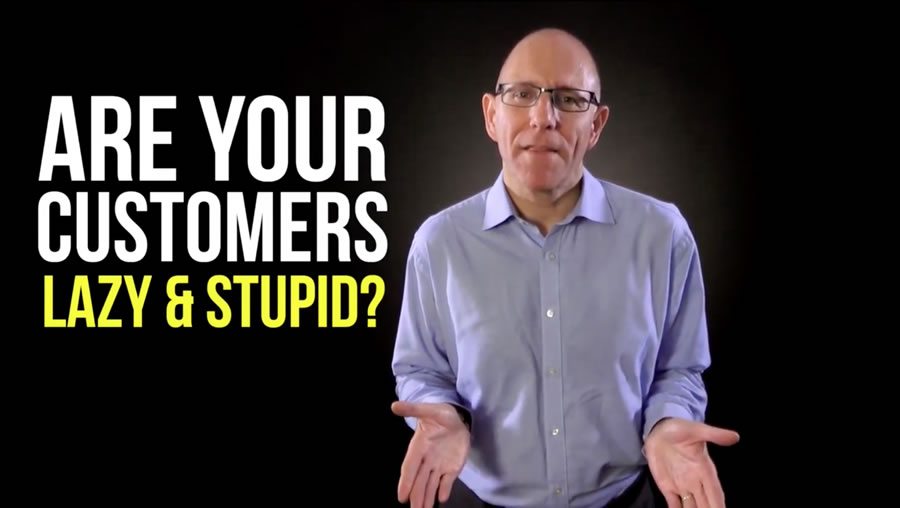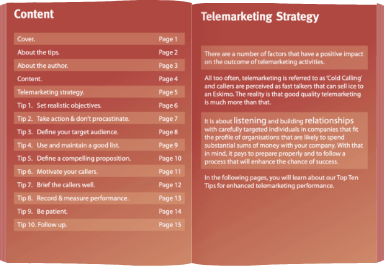Are Customers Lazy and Stupid? That’s a pretty bold statement with which to start a blog, perhaps. But, take a moment to think about what’s behind the statement. Have you ever had any of these thoughts?
- Surely, it’s a no-brainer?
- Why can’t they see what I can see?
- It will help them enormously but why won’t they pull their finger out?
Businesses are focused on business development so it doesn’t help when potential customers don’t play ball. What stops most customers from buying? In truth, there could be any number of reasons. They may not like you. They may not like your products or services. Your credentials or reputation may not be up to scratch. I could go on.
Inertia is the easy option
The point is that often in business, inertia is the easy option. Buyers are busy. They usually have a huge number of things on their plate, or at least they think they do. They often run multiple projects or handle various tasks at one time. Therefore, any change involves shifting the status quo. And that can be a challenge. It takes their eye off the balls they’re already juggling.
So, we need to delve into the psychology of buying to get closer to why customers buy and how you can tap into that psyche. It’s well known that individuals typically buy on pain or gain. It’s about gratification or alleviating something that causes stress or hassle. It’s either about stopping something happening or lessening its impact or doing something to improve or develop something within the business.
We all have competing priorities
Despite this, workload, the day job and other priorities kick in. Even what seems a no brainer, may not seem like that to a buyer that’s under pressure to meet a deadline. Assuming that it’s genuinely not you or your product that is putting them off, or you’ve completely misread the need, it’s probable that their vision is clouded by other things going on in the business. It’s not that they’re stupid because they can’t see what you can see. It may be just that other factors are more immediate that take their attention away from what you’d like to do for them.
Even if they aren’t up against it on a specific project, their personal and business objectives may mean that their attention is focused elsewhere. In other words, when you come knocking, your sales pitch is low down the totem pole of priorities. And, that could even be when they’ve come to you with an enquiry. They may have been asked by their boss to do some digging into solutions. However, the requirement may not be for right now. What’s more, things change fast and what may have been a priority today may drop like a stone in terms of immediacy tomorrow.
So, what can sales-people do to mitigate this? First of all, you need to identify and sell to those buyers that are in the market right now. You deploy traditional sales techniques and use your experience to make sure you get on those shortlists and convert. But, for the others, it can be slow burn and considerably more difficult to move the buyer towards entertaining your solution and any change that entails. There are a number of things to consider:
Recognise that you’re building your sales pipeline
It may be a bit of a cop out to say not everyone is a genuine customer and that not everyone will buy. However, it is true. Equally, part of the reason for building your sales funnel or pipeline to a decent number of prospects is indeed to cater for those that fall by the wayside. Some potential customers will never buy from you. Some will never buy at all and decide to either shelve the project or find another solution. So, you have to develop your pipeline alongside some degree of realism whilst doing your best to try to convert those that are genuinely in the market.
Work out the timeframe
Clearly, if a customer contacts you with an inbound enquiry, they are more likely to be in the market for your services. But, they wouldn’t be the first tyre kickers to test drive a vehicle and fail to buy. So, you still need to identify the warmth of the enquiry and the immediacy of their need before moving to the phase where you try to convince them that your solution and cost meets their needs better than competitors.
Probe with good questions
Questions are vital regardless of how you found the prospect. However, where you approach potential customers (as opposed to receiving inbound enquiries) that are not specifically in the buying cycle, you need to do more work. That’s where good questioning comes in so that you can unearth the opportunity and flush out the issues that would convince them to overcome natural inertia.
Effective questioning and good listening skills are pre-requisites but it’s more than that. With purchases of significant value and importance, trust kicks in and increases in importance. The buyer needs to know they are purchasing from a reputable source. They need to know that they can trust you to deliver on your promises. They need to consider you and your company as a trusted advisor. The only way to do this is to demonstrate genuine interest in them. That means allowing them to talk and encouraging them to do so. It means talking less, asking relevant and engaging questions and listening more.
Work on your rapport skills
Linked to the above, without building rapport with your prospective client, it’s unlikely you’ll be at the starting post let alone reach the finishing line. Whilst many purchases are completed online, the higher the value, the more likely it is that human intervention is required. Hence, since people still buy people, if you want to get down to the final few contenders for the prize, you need to be able to engage with your prospect.
Rapport building means finding common ground both personally and professionally. It means exploring all of the options with them even those that do not include your solution. It doesn’t mean wasting time chatting away unnecessarily when there’s no end in sight, but if the value of sale warrants the investment in time, it does mean building a relationship borne out of trust that could bear fruit further down the line even if now doesn’t pay off. After all, these same buyers may have a future need. They may have a requirement at a new organisation. And, they’re more likely to consider you and your organisation if you’ve taken the time to understand their needs.
Ensure you get a time to follow up
Not every sale closes straight away. Sadly, but inevitably, some will never come to fruition. Either way, a sales close isn’t always about now. If you push too early, you’ll damage trust and credibility. So, you may need to work on relaxing more into the conversation to take the pressure off yourself. The purchase could be delayed for all manner of reasons. Companies select different routes to solve their immediate problems and deal with their needs. Therefore, if you can’t move things forward immediately, at the end of every interaction it’s essential that you agree next steps.
Even if the next step is as simple as a call back in 1, 3, 6 or 12 months, make sure that, once you’ve profiled the customer so that you’re satisfied that they are a valid target, you agree a time to call back. Psychologically, there is a world of difference between calling and saying ‘you asked me to call you back in June’ and not having agreed a call back where the customer is on the back foot the next time you call. They will be more likely to push you away without the agreement for the follow-up.
Learn to handle objections
In this blog, we haven’t covered specific objection handling techniques. Naturally, handling objections is a fundamental factor in lead generation success. You will often need to break down objections into manageable chunks. That’s where effective questioning skills come in handy once again. You also need to use questions to move customers off the fence. However, without understanding the reasons why customers might be holding back, you won’t get far. A straightforward question/statement such as ‘I sense that you’re not comfortable about moving forward. Can I ask, what is it that’s stopping you from making a decision?’ may help move the discussion towards a conclusion one way or the other.
Ultimately, prospective customers aren’t lazy or stupid. We all have tasks that absorb our time. We have communication clutter and overload that sometimes prevent us from focusing. We are all buyers of products and services and we do the same thing to our suppliers. So, try to step into your buyers’ shoes for a moment. Look at things from their perspective. And, whilst you’re adding some prospects to ‘future’ as opposed to current interest or labelling them as warm as opposed to hot prospects, you’re continuing to build your pipeline. Filter out the prospects that are genuinely unlikely to convert and ensure that you also move on to other customers that are ready to buy now.
GSA helps businesses become more effective in their marketing and business development. We run outbound telemarketing campaigns into the UK, Europe and further afield. Also, with our experience, we provide telemarketing training to help sales teams improve their results. If you’d like to know more, give us a call.






